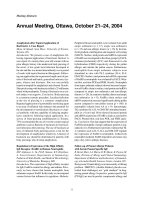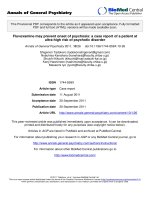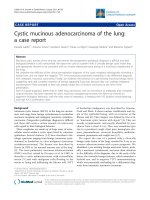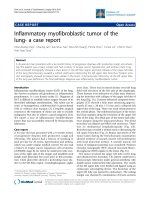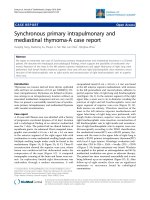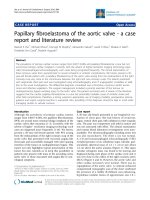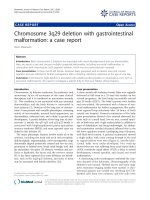Báo cáo y học: "Unusual insidious spinal accessory nerve palsy: a case report" ppt
Bạn đang xem bản rút gọn của tài liệu. Xem và tải ngay bản đầy đủ của tài liệu tại đây (617 KB, 5 trang )
JOURNAL OF MEDICAL
CASE REPORTS
Charopoulos et al. Journal of Medical Case Reports 2010, 4:158
/>Open Access
CASE REPORT
© 2010 Charopoulos et al; licensee BioMed Central Ltd. This is an Open Access article distributed under the terms of the Creative Com-
mons Attribution License ( which permits unrestricted use, distribution, and reproduc-
tion in any medium, provided the original work is properly cited.
Case report
Unusual insidious spinal accessory nerve palsy: a
case report
Ioannis N Charopoulos*
1
, Nikolas Hadjinicolaou
1
, Ioannis Aktselis
1
, George P Lyritis
2
, Nikolaos Papaioannou
2
and
Constantinos Kokoroghiannis
1
Abstract
Introduction: Isolated spinal accessory nerve dysfunction has a major detrimental impact on the functional
performance of the shoulder girdle, and is a well-documented complication of surgical procedures in the posterior
triangle of the neck. To the best of our knowledge, the natural course and the most effective way of handling
spontaneous spinal accessory nerve palsy has been described in only a few instances in the literature.
Case presentation: We report the case of a 36-year-old Caucasian, Greek man with spontaneous unilateral trapezius
palsy with an insidious course. To the best of our knowledge, few such cases have been documented in the literature.
The unusual clinical presentation and functional performance mismatch with the imaging findings were also observed.
Our patient showed a deterioration that was different from the usual course of this pathology, with an early onset of
irreversible trapezius muscle dysfunction two months after the first clinical signs started to manifest. A surgical
reconstruction was proposed as the most efficient treatment, but our patient declined this. Although he failed to
recover fully after conservative treatment for eight months, he regained moderate function and is currently virtually
pain-free.
Conclusion: Clinicians have to be aware that due to anatomical variation and the potential for compensation by the
levator scapulae, the clinical consequences of any injury to the spinal accessory nerve may vary.
Introduction
Isolated spinal accessory nerve dysfunction has a serious
impact on the functional performance of the shoulder
girdle. The role of the trapezius muscle in shoulder girdle
kinesiology is fundamental, since it contributes to the
scapulothoracic rhythm by elevating, rotating and
retracting the scapula. Although spinal accessory nerve
palsy is a well-documented complication of surgical pro-
cedures in the posterior triangle of the neck [1,2], several
other possible causes have been proposed [3-6].
The usual initial presentation is that of severe neck and
shoulder pain, sometimes radiating to the arm but with-
out the initial palsy [7-9]. The isolated spinal accessory
neuropathy usually becomes evident after a few days,
with weakness in the abduction and anterior elevation of
the arm, and with atrophy of the trapezius muscle and
winging of the scapula after a few weeks. Occasional vari-
ations in the clinical findings of patients with identical
lesions of the spinal accessory nerve may be partially
explained by variations in the innervations of the trape-
zius muscle [7].
It is essential to recognize the condition and its variants
promptly and in the early stage so as to avoid the reduc-
tion of scapulothoracic motion which occurred with our
patient. We report a case of spontaneous unilateral trape-
zius palsy with an insidious course, which has been docu-
mented in only a few instances in the literature [3,8,9].
Moreover, parameters such as our patient's unusual ini-
tial clinical presentation, the magnitude of the functional
deficit and its mismatch with the imaging and electro-
physiological findings, as well as a possible pathomecha-
nism of the present injury, are discussed in this case
report.
Case presentation
A 36-year-old Caucasian, Greek man presented to the
out-patient clinic of KAT hospital complaining of weak-
ness and limited range of motion of his right shoulder. He
had noticed, over the past two months, that abduction
* Correspondence:
1
Fifth Orthopedic Department, KAT Hospital, 14561, Greece
Full list of author information is available at the end of the article
Charopoulos et al. Journal of Medical Case Reports 2010, 4:158
/>Page 2 of 5
and elevation of the joint had gradually become limited
while he was carrying his newborn child in a baby basket.
He denied any neck or shoulder pain and could not recall
a specific precipitating traumatic event or any recent epi-
sode of respiratory infection. However, he reported that
his job was a heavy manual one, requiring lifting and car-
rying heavy objects on his shoulders. Our patient had no
significant medical history.
Physical examination revealed a winged scapula and
asymmetry of his shoulders, with right shoulder depres-
sion (Figure 1). He was unable to abduct his right arm
above 80° in the frontal or scapular plane while his for-
ward elevation was slightly reduced. His passive range of
motion was comparable to the normal left side. Scapular
winging was marked during abduction and disappeared
in forward elevation, while it was only slightly evident at
rest (Figure 2). Furthermore, there was a marked wasting
of his right trapezius muscle with decreased shrugging of
the affected shoulder. Both wasting and weakness were
not observed in the ipsilateral sternocleidomastoid mus-
cle, and a neurological examination did not reveal other
cranial nerve deficits. No brachial plexus neurological
signs were detected. Our patient's rotator cuff was judged
to be intact.
Results of his complete blood count, erythrocyte sedi-
mentation rate (ESR), C-reactive protein (CRP), and
serum biochemistry were all normal. The initial X-rays of
his right shoulder region were unremarkable. Computed
tomography (CT) of the shoulder girdle of our patient
revealed significant diffuse trapezius muscle wasting (Fig-
ure 3). Magnetic resonance imaging (MRI) of his cervical
spine, right shoulder joint and skull base identified no
pathology except mild atrophy of his right sternocleido-
mastoid and trapezius muscles (Figure 4).
Nerve conduction study of our patient's right spinal
accessory nerve, with surface stimulation along the poste-
rior border of the sternocleidomastoid muscle and
recording from the trapezius, produced no compound
muscle action potential. A needle electromyography
(EMG) of the right trapezius muscle revealed signs of
active denervation (fibrillation potentials and positive
sharp waves), atrophy (marked diminution of insertional
activity), and severe axonal damage (no recruitment of
motor units). Meanwhile, EMG of his right sternocleido-
mastoid muscle showed findings suggestive of mild
axonal injury (decreased recruitment, polyphasicity and
prolonged duration with increased amplitude of motor
unit potentials). His levator scapulae, serratus anterior
and rhomboid muscles were normal. Electrophysiological
findings suggested an axonal degeneration of his right
spinal accessory nerve that was mainly distal to the inner-
vation of the sternocleidomastoid muscle, and an irre-
versible denervation of his right trapezius muscle.
Consequently, a diagnosis of spontaneous chronic right
spinal accessory nerve palsy was established, although
Figure 1 Frontal and dorsal views demonstrating the right neck
asymmetry and ipsilateral shoulder depression (red arrow). The
right scapula's medial wall (red line) is translated laterally, as it is evi-
dent with its increased distance from the body's midline (black line).
Figure 2 Scapular winging at different angles of arm abduction.
Figure 3 Transverse views of computed tomography scans reveal
marked wasting in the muscle bulk of almost all parts of the right
trapezius (arrows).
Charopoulos et al. Journal of Medical Case Reports 2010, 4:158
/>Page 3 of 5
not affecting some fibers to the sternocleidomastoid
muscle.
The chronic nature of our patient's lesion and the den-
ervation of his trapezius muscle with severe loss of most
of its motor units suggested the appropriate treatment
procedure was dynamic muscle transfer using the levator
scapulae and the rhomboid muscles. Our patient refused
the recommended treatment, since he felt that his pain-
less disability did not justify this highly demanding proce-
dure. Instead he followed a specific program of
physiotherapy, focusing on resistance exercises to pro-
gressively strengthen the adjacent scapular muscles and
on exercises to preserve the maximum range of motion of
his shoulder joint.
Thereafter, he was followed up every month for assess-
ing and modulating the progress of his rehabilitation pro-
gram and for subsequent EMG investigations. At the last
follow-up, eight months after the onset, a slight improve-
ment in the active abduction of his arm and in his neck
asymmetry was observed. Significantly, his scapular
winging remained painless, with no associated neurologi-
cal deficits. Our patient was also able to perform his man-
ual work, at approximately the same level as before. A
repeat EMG did not show any alterations from the initial
electrophysiological findings.
Discussion
The role of the trapezius muscle in shoulder girdle kinesi-
ology is fundamental, since it supports the entire weight
of the upper extremity in the erect position, along with
the levator scapulae muscle. Moreover, its middle portion
is the initiator of upward rotation of the scapula, while its
upper and lower portions elevate the lateral angle of the
scapula and pull down the medial edge of the scapular
spine [10]. Also, shrugging of the shoulder and retraction
of the scapula rely mainly on this muscle. In summary, it
contributes to the scapulothoracic rhythm by elevating,
rotating and retracting the scapula.
Trapezius muscle dysfunction causes drooping of the
shoulder, asymmetry of the neckline, winging of the scap-
ula, and weakness of forward elevation and abduction
movements. Furthermore, the intricate balance of muscle
forces about the scapula is disrupted and the smoothness
of the scapulohumeral rhythm is lost. Concerning scapu-
lar winging, the scapula assumes a depressed and lateral
translated position, while the inferior scapular angle
Figure 4 Magnetic resonance imaging of the neck showing muscle wasting of the right trapezius (red arrows) and sternocleidomastoid
(yellow arrows) muscles.
Charopoulos et al. Journal of Medical Case Reports 2010, 4:158
/>Page 4 of 5
rotates laterally [4] (Figure 1). Therefore, this lesion can
be not only painful but also deforming and disabling [2,3].
The pain that develops can be quite severe because of
muscle spasm, radiculitis from traction on the brachial
plexus, frozen shoulder, or subacromial impingement.
Aching may radiate to the medial margin of the scapula
and down the arm to the fingers, and is also sometimes
incapacitating [7].
In our case report, we illustrate spinal accessory nerve
palsy of spontaneous insidious onset, which has been
described in only a few instances in the literature [1,7-
9,11,12]. Although our case demonstrated common clini-
cal signs of this pathology, we have observed certain
unique characteristics of patient. First, his main concerns
and complaints were right shoulder weakness and
decreased active range of motion, and not pain or neuro-
logical symptoms which are mostly reported in the litera-
ture. Furthermore, severe trapezius muscle dysfunction,
as assessed by EMG, revealed that the spinal accessory
nerve dysfunction of our patient must have pre-existed
before becoming clinically apparent. In other words, this
latency period supports our hypothesis of the insidious
nature of the lesion and our view that it eventually
emerged when the compensatory mechanisms were
exhausted.
The initial painless clinical presentation, along with the
limited functional deficit even after eight months, were
not consistent with our imaging and electrophysiological
findings. The extent of the trapezius muscle atrophy
could have produced a gamut of symptoms including rad-
iculitis, restriction of passive shoulder motion, and
impingement. By contrast, this case shows unusual fea-
tures with constant discomfort due to neckline asymme-
try and restricted arm abduction. The compensatory
action of the other scapular stabilizers seems to explain
this inconsistency.
The mild handicaps and good results after conservative
treatment reported in other cases of spontaneous onset
[7,8,11,12] did not apply in our case. Our patient showed
irreversible deterioration of his trapezius muscle function
quite early, two months after the appearance of his first
clinical signs, which was different from the usual out-
come of such a lesion. The massive trapezius muscle atro-
phy with the severe loss of most of its motor units seemed
to exclude the usually proposed surgical procedures of
neurolysis and nerve grafting [13,14]. However, there are
reports of poor results after microsurgical repair of
nerves in cases of spontaneous trapezius palsy [1].
Although transfer of the levator scapulae and the rhom-
boids to substitute for the three components of the trape-
zius muscle appeared to be the most appropriate
treatment, our patient declined it because he was pain-
free and willing to accept his functional disability. Our
patient failed to make a full recovery after conservative
treatment for eight months. He regained moderate func-
tion and was virtually pain-free.
The main cause of trapezius palsy is injury to its major
nerve supply, the spinal accessory nerve. The superficial
location of the spinal accessory nerve, in the subcutane-
ous tissue on the floor of the posterior cervical triangle
makes it vulnerable to injury [2]. This palsy is commonly
seen after surgical procedures in the posterior cervical
triangle for malignant diseases and after penetrating inju-
ries [1,2]. Other reported mechanisms of injury include
blunt trauma or a direct blow in the neck region [2,5],
compression by tumors at the base of the skull [6], frac-
tures involving the jugular foramen [4], and stretching of
the nerve after depression of the shoulder with the head
being forced in the opposite direction [12]. Isolated rare
causes that have been reported are aneurysm formation,
whiplash injury, acromioclavicular or sternoclavicular
dislocation and catheterization of the internal jugular
vein [1].
Long-standing heavy manual work, including carrying
heavy objects on the shoulder, seem to have been be the
precipitating factor for the spontaneous insidious onset
of trapezius palsy in our patient. The ensuing repetitive
microtrauma caused localized spinal accessory nerve
compression and subsequent aseptic inflammation,
which caused deterioration in the trapezius muscle. This
hypothesis justifies the insidious and chronic nature of
the observed functional deficit.
Electrophysiological findings revealed greater dysfunc-
tion of the trapezius muscle relative to the ipsilateral ster-
nocleidomastoid muscle. The vulnerability of the spinal
accessory nerve fibers supplying the trapezius muscle
selectively could be explained by their superficial ana-
tomic location in the posterior cervical triangle, just cau-
dal to the branch for the sternocleidomastoid muscle.
The lesser severity of the electrophysiological changes
obtained for the nerve fibers innervating the sterno-
cleidomastoid muscle could be explained by the deeper
anatomic location of the specific nerve branch and possi-
bly by the spatial topographic distribution of the fibers in
the spinal accessory nerve. This is quite ambiguous since
it is not well discussed in the relevant literature.
Idiopathic isolated spinal accessory palsy should have
been considered in the differential diagnosis of our
patient, since similar cases have been reported [8,15].
Distinguishing neuralgic amyotrophy from gradual com-
pression palsy, based solely on presenting symptoms and
clinical and electrophysiological examinations, is quite
challenging. Furthermore, neither pain characteristics
nor the resultant weaknesses can distinguish these two
causes [15]. In the current report, the insidious course of
the deficit, the lack of pain at the initial presentation and
the relatively sparing of sternocleidomastoid nerve fibers
Charopoulos et al. Journal of Medical Case Reports 2010, 4:158
/>Page 5 of 5
favour localized nerve compression over neuralgic amyo-
trophy as the most probable cause.
Conclusions
The clinical relevance of our case report focuses on the
significance of the hierarchical clinical evaluation of the
shoulder girdle kinesiology. In particular, we highlight the
significance of clinical examination assisted by the find-
ings of different imaging modalities and the use of EMG
in assessing the broad spectrum of causes of scapulotho-
racic dyskinesia. It is stressed that the dynamic motion of
the scapulothoracic articulation should be evaluated as a
co-ordinated movement of the muscle units of the shoul-
der. Therefore, in order to plan treatment, clinicians
should evaluate each unit of scapulothoracic motion sep-
arately and should be aware that anatomical variations
and the potential for compensation by the levator scapu-
lae may cause the clinical consequences from any injury
to the spinal accessory nerve to differ.
Consent
Written informed consent was obtained from the patient
for publication of this case report and any accompanying
images. A copy of the written consent is available for
review by the Editor-in-Chief of this journal.
Competing interests
The authors declare that they have no competing interests.
Authors' contributions
INC co-ordinated the diagnostic and therapeutic approach and conceived the
idea of presenting the case report. NC and IA assisted in the sequential imag-
ing control and in the preparation and drafting of the manuscript. CK assisted
in the drafting of the manuscript. NP and CK made the final check and
approval of the submitted manuscript. All the authors read and approved the
final manuscript.
Author Details
1
Fifth Orthopedic Department, KAT Hospital, 14561, Greece and
2
Laboratory
for Musculoskeletal System Research, Medical School, University of Athens,
Greece
References
1. Teboul F, Bizot P, Kakkar R, Sedel L: Surgical management of trapezius
palsy. J Bone Joint Surg Am 2004, 86A(9):1884-1890.
2. Wright TA: Accessory spinal nerve injury. Clin Orthop 1975, 108:15-18.
3. Bigliani LU, Perez-Sanz JR, Wolfe IN: Treatment of trapezius paralysis. J
Bone Joint Surg Am 1985, 67A:871-877.
4. Fiddian NJ, King RJ: The winged scapula. Clin Orthop 1984, 185:228-236.
5. Hirasawa Y, Sakakida K: Sports and peripheral nerve injury. Am J Sports
Med 1983, 11:420-426.
6. Kubota M, Ushikubo O, Miyata A, Yamaura A: Schwannoma of the spinal
accessory nerve. J Clin Neuroscience 1998, 5(4):436-437.
7. Donner TR, Kline DG: Extracranial spinal accessory nerve injury.
Neurosurgery 1993, 32:907-911.
8. Eisen A, Bertrand G: Isolated accessory nerve palsy of spontaneous
origin. Arch Neurol 1972, 27:496-502.
9. Van Tuijl JH, Schmid A, Van Kranen-Mastenbroek V, Faber CG, Vles JSH:
Isolated spinal accessory neuropathy in an adolescent: a case study.
Eur J Paed Neurol 2006, 10:83-85.
10. Kuhn JE, Plancher KD, Hawkins RJ: Scapular winging. J Am Acad Orthop
Surg 1995, 3:319-325.
11. Berry H, MacDonald EA, Mrazek AC: Accessory nerve palsy: a review of
23 cases. Can J Neurol Sci 1991, 18:337-341.
12. Mariani P, Santoriello P, Maresca G: Spontaneous accessory nerve palsy.
J Shoulder Elbow Surg 1998, 7:545-546.
13. Logigian EL, McInnes JM, Berger AR, Busis NA, Lehrich JR, Shahani BT:
Stretch-induced spinal accessory nerve palsy. Muscle Nerve 1988,
11:146-150.
14. Ogino T, Sugawara M, Minami A, Kato H, Ohnishi N: Accessory nerve
injury: conservative or surgical treatment. J Hand Surg 1991,
16B:531-536.
15. Baker SK: Isolated spinal accessory mononeuropathy associated with
neurogenic muscle hypertrophy: restricted neuralgic amyotrophy or
stretch-palsy? A case report. Arch Phys Med Rehabil 2008, 89:559-563.
doi: 10.1186/1752-1947-4-158
Cite this article as: Charopoulos et al., Unusual insidious spinal accessory
nerve palsy: a case report Journal of Medical Case Reports 2010, 4:158
Received: 4 November 2009 Accepted: 27 May 2010
Published: 27 May 2010
This article is available from: 2010 Charopoulos et al; licensee BioMed Central Ltd. This is an Open Access article distributed under the terms of the Creative Commons Attribution License ( ), which permits unrestricted use, distribution, and reproduction in any medium, provided the original work is properly cited.Journal of Medical Case Reports 2010, 4:158
